#also cleaned up the blog a bit
Text
hey if you're here expecting daily writing it's not gonna happen ♥
#i don't get sending me stuff then promptly unfollowing but u do u#sorry i'm not fast and it's stated /multiple/ times across my blog#if you'd like to dip pls do so now so i can delete drafts.............#mwah ♥#also cleaned up the blog a bit#and now i'm gonna go hide bc ruined mood#pls come plot?#ims or disco are always open :/#festive fruitcake 🌟🎄#6427
0 notes
Text

a digitally colored paper doodle of N i drew earlier today before one of my exams started
#also cleaned up the doodle a bit in the face and bangs area#nowhere else because i couldn’t be bothered to do completely today. nonetheless ‘tis him :]#N the greatest#<- I AM MAKING A TAG ON MY BLOG FOR HIM. IT IS MY BLOG I GET TO DO WHATEVER I WANT TO#n pokemon#n harmonia#natural harmonia gropius#pokemon#pokemon black and white#yomoart
78 notes
·
View notes
Note
sorry if u already answered this question, but how do you scan your art? like via phone or a printer or smth else? It looks so good!🙏
I usually scan with a flatbed scanner in 400dpi, as I found it gave me the nicest quality without being too large, but 300dpi is also fine.
The secret to getting good scan quality is Know Thy Printer. Every scanner has its unique traits you want to compensate for, be it low contrast, over saturating, or washing out colours. My great art hack is adjusting for this post scan! I found duplicating and multiplying the layer (fading opacity based on need) helped fix a *lot* of issues with the ink scanning ‘washed out’.
#ask#art faqs#cause I have a few more asks like this to answer and expect to have more#I have actually switched scanners a *lot* over the run of this blog#i kinda live a nomadic lifestyle and dont stay in one place permantly so its a necessity to borrow a scanner when I can#i actually have memorized/writen down the exact numbers for adjustments for each scanner i frequent#but after a while you can develop a sense of what settings you need to pull up#i use a cracked copy of Sai; the one I last used needs +12% contrast adjustment and multiply on 75%#stuff like that!#ive also has a scanner than needed 25% colour adjust and 50% multiply#it takes a bit of playing around with to get familiar but wow its made a difference#Id say the multiplied layer adjustment is the most key aspect into getting a clean scan! Higher contrast to sharpen edges!#Lots of free programs can do that too!
57 notes
·
View notes
Text

The district has been placed under quarantine for the time being. Officials suggest all locals avoid any silverfish or silverfish-like creatures, as there are multiple missing person reports coming in at this time.
#minecraft#mineblr#modded minecraft#what is this blog if not to be a little bit silly. a little goofy even.#AKA herobrine spawned a lava trap and i broke in trying to get the lava. but the possessed silverfish spawned and Didn't Like That#but because it was close enough it also ruined the second E and changed the first E to an F#f-nr.#in my attempt to clean up the silverfish i got teleported away twice#once 200 ish blocks away another ~450 blocks#the latter of which was straight into a pillager camp with like 10 guys trying to kick my ass#(i won)#but like. if the silverfish affected villagers?? rip#hence. the missing person reports <3#i love fictional lore
7 notes
·
View notes
Text
I Kind of Wanna Talk About the Translation of Digimon Liberator
So change of plans, I'm gonna pause before reading chapter 2 and talk about the translation so far. Full disclosure: I have a BFA in English and a lengthy background in Creative Writing. I only have like, a child's level of conversational Japanese under my belt, meanwhile. But our system is really fascinated with translation theory.
This isn't the first time I've talked about translation theory in Digimon on this blog, either (see this post), so if you're a regular, some of this might be familiar territory.
I'll only be talking about official profiles and chapter 1 for now, because I can't keep the thoughts quiet enough to read chapter 2 lmao.
[REALLY REALLY LONG POST BELOW THE CUT, I'M SERIOUS]
Defining Translation Theory
Before I can talk about the translation of Digimon Liberator, I want to briefly explain the concept of translation theory, as it's something I'm fairly interested in exploring through the Digimon franchise.
Translation theory is, essentially, the drive behind how a text is translated from one language to the next. Kind of self explanatory on the surface, it's complicated by the medium of a text, as well as whether certain elements can be cleanly translated from one language to another.
In this conversation, "original language" will refer to the language a text was in prior to translation. For Digimon, that's Japanese. "Host language" will refer to the language a text was translated into. For what I can read, that's English.
Certain mediums lend themselves well to translator's notes. If you've ever picked up a work in translation, this may be a foreword from the translator in books. Those of you familiar with fan subs will know these as those notes that show up on the top of the screen whenever something needs more context to fully convey (such as a linguistic joke or cultural reference).
I'm going to use an example from Charles Baudelaire's Les Fleur du Mal, my go-to on this topic thanks to how many translations there are and the fact that Les Fleur du Mal is a poetry collection. Specifically, i want you to look at "L'Albatross," (literally "The Albatross" in English). These two sites have a lot of translations (and the first site has the original French text available to read as well).
I'm not going to make you read all of the translations, but I do want them to help you understand the different ways translation theory can affect a text in its host language. Scan through a few and it becomes clear that every translator did something at least a little different. With poetry, this is quick to spot, because how a line reads can drastically change how the poem itself lands with an audience.
Generally, a few questions should come to mind when you're reading a translated work. This list isn't every question you should (or could) ask, of course, but these are some of the ones I think of:
Is this translation intended to be a literal (as close to 1:1) translation?
Additionally, is a literal translation even possible, linguistically?
If not, what form of writing is the translator engaging in?
(For example: if the original work has references to culturally distinct idioms, does the translator literally translate those idioms, or do they look for the closest idiom in the host language that conveys a similar meaning?)
The same can be asked of figurative language. What similes, metaphors, and so on are changed to make more sense in the host language, if at all?
What linguistic bias is on display in translation?
(A good example for understanding this would be the translation theory of Emily Wilson, who was the first woman to translate The Odyssey into English. She noticed a bias in the interpretation of language by her male predecessors in the field. More on that in the many articles she's been interviewed for, but I'll highlight the one she wrote for TIME back in 2017.)
And, perhaps, what is lost in the oral quality of a translation?
(Turning back to Baudelaire for a moment, French sounds different from English, on a fundamental level. Will a translator attempt to preserve the meterical qualities of an original work? Oral qualities refer to anything that can be heard when read aloud. Assonance, consonance, rhyme, slant rhyme, etc.. I think this is the easiest example to ponder over what is lost in translation, because it is fundamentally tied to the language itself.)
Okay, We Can Talk About Digimon Again
So, Digimon Liberator (in both forms) is a work in translation from its original language of Japanese. I think I'm not alone in saying that, regarding the comic's translation, everything looked pretty clean, showing an intent on Bandai's part to make sure the comic was legible to a Western audience.
I didn't notice any weird linguistic artifacts in the comic, and I haven't seen anyone complaining about its translation here on tumblr. I'm not talking about the comic, because I think the translation method applied is extremely effective!
Similarly, there are "lore" articles that explain the mechanics of the fictional universe from an in-universe perspective. They're written like promotional guides for players, and I think the style employed there works quite well. Any stiffness in the writing feels expected, because it's an in-universe article, where formality and a bit of reservation should be used.
What I want to talk about specifically is Chapter 1 of the novel. I just got done reading it (about an hour ago at this point since I've been working on this post so long lmfao).
It's obvious to me that a lot of thought is going into how this series is being translated. Similarly, it's obvious that it's not being machine-translated. My biggest examples for this come from two things I've noticed so far:
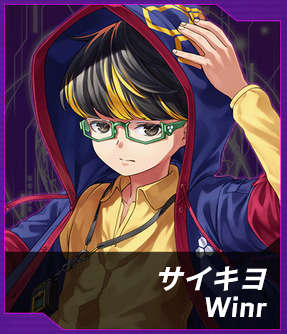
[ID: A screenshot of the Digimon Liberator official thumbnail for Winr's profile. Winr is a boy with pentagonal, green-framed glasses over his brown eyes. He has a neutral expression on his face. He wears a short sleeved blue and red hoodie with gold honeycomb patterns over a long sleeved yellow dress shirt. On a lanyard around his neck is a black and gold Digimon v-pet.]
This is Winr. Or, for those of you who can read Katakana, this is "Saikyo." I think it's actually "Saikiyo?" My point stands either way. If it's just "Saikyo," it's literally the superlative for "strongest." If it is "Saikiyo," I'm fairly certain it's still meant to evoke the word.
Why am I certain of that? Well, because his name in the host language is "Winr!" Which is a play on the word... well, "winner!"
I doubt a machine translation would be able to make this kind of wordplay, and it evidences to me that there is thought going on behind this translation and its legibility in its host language.
My other example is...

[ID: A screenshot of text that reads:
"Please, I'll buy you some cute accessories next time, so please forgive me, Impmon!"
"Ha! No way! I won't forgive you until you reflect on what you did!"
"But what if it's like…mad cayuute?"
"I don't need no darn cute accessories! And what do you mean by mad cayuute? Just say it's 'really cute'!"]

[ID: A screenshot of Japanese text that reads:
「お願い、こんどかわちいアクセサリー買ってあげるからゆるして、インプモン!」
「やーだーねー! 今日ばっかりはユウキが反省するまでゆるさねーからな!」
「でも“エグい”くらい“かわちい”よ……?」
「カワチイアクセサリーなんていらねンだよ! っていうかなーにがエグいだ! なにがカワチイだ! ちゃんと“スゴく”“可愛い”って言え!」]
Okay. Bear with me on this one. My Japanese isn't good enough to be able to read a literal translation on the whole section here, but I was curious about the "mad cayuute?" line in English. That struck me as a "this is something translated from a joke I might not get otherwise" line, especially with that phonetic drawing out of "cute."
Someone who's more fluent in Japanese might be able to help me out, because Impmon's speaking above my expertise LMAO.
In the third line of dialogue in the Japanese version, Yuuki says this word "かわちい" (phonetically, "kawachii"). I think it's interesting to see that it's even couched by quotation marks. I'm not as familiar with Japanese formatting, but it wouldn't surprise me if the use of quotation marks here is to bring attention to the way Yuuki speaks. The same formatting is used with "エグい" (phonetically, "egui") earlier in the line, which does have a literal translation as an adjective (I'm not listing out all the definitions I'm finding because I don't want to get too into the weeds with a language I have very minimal experience with though).
So What Does This Mean?
Like I said, the way the translation is being done suggests to me that there is at least one actual person working on the translation work. I don't know how many people are working on the translation team, as I can't find any credits on the site itself.
That said, I find it refreshing that there is evidence of some thought being put into the translation of the web novel. Now, I don't know what the deal was with Seekers, because I genuinely could not get myself interested in it. As much as I would love to do some comparative analysis of the translation in Liberators versus the translation in Seekers, you cannot convince me to read Seekers. I just don't have the patience.
Now, why do I bring this up?
Well, while I can't compare Liberators to Seekers, I do know some people had issues with the way Seekers was written. I think, reading Liberators, I want to talk about my criticisms with, strictly, the formatting and prose in the host language.
As we saw in the second example above, Japanese and English prose are formatted very differently. Those of you who also read through the Liberator chapters may have noticed that a lot of the dialogue is paragraphed in a way that groups them together. This is my first issue with the translation so far. I don't think Bandai will change the format (and I admit, it's helpful for doing comparative analysis like I did above), but separating out dialogue in English is important for legibility.
So too are dialogue tags, which aren't present in the original language in the same section I highlighted. In the section I used as an example, this isn't an issue, as both Yuuki and Impmon use each other's names in dialogue, marking the back and forth for the reader. But there was an example in chapter 1 that I needed to go back and reread after the paragraph.
(From Chapter 1.2)

[ID: Screenshot of text that reads:
"Anyway, it’s been bothering me. We could chalk it up to a bug, but there's something fishy about the new ability item and cards."
“Ah, I agree. It’s kinda bothering me, too. Maybe we should consult Altea next time?"
"Eh, I don't really like that Altea."
The Altea that Yuuki mentioned is a member of the debugging team who supports them behind the scenes. Typically, she works alongside the Digimon Espimon to assist the GMs. Undoubtedly, Altea is the most knowledgeable about the system within their team and a reliable figure indeed.]
I'm not going to dig for the quote in Japanese, if only because I want to focus on the English translation here. If it's a matter of character voice, there's some argument that maybe the translation could have done something to differentiate Yuuki and Impmon here. However, while it would be an additive change, I think that the inclusion of dialogue tags would be the least intrusive means of preventing the kind of confusion I experienced with this section.
Anyone familiar with English prose will know that it's common in the beginning of a dialogue section to denote who's speaking within the first line or two of dialogue, especially with dialogue that does not communicate character on its own. Since it's just two people talking, you only need to show who one of the speakers is.
Ultimately, this is kind of an editing nitpick, and I'm really only bringing it up because I noticed it as an artifact of translation, rather than a sign of bad writing. Honestly, I'd love to learn more about formatting in Japanese novel writing, but that's a deep dive I'm not ready to embark on for a silly little tumblr post I'm writing about my initial thoughts about translation quality in Digimon Liberator. I do want to encourage everyone reading to consider translation theory when they're reading Liberator though, because it plays into the limitations of the medium.
The bigger issues I had with the translation are twofold: tense and syntax.
Tense is going to be easier to discuss here. The easiest way to explain it is thus: tense denotes temporality. "I ate a bagel" means that there is no longer a bagel in my bread box; "I am eating a bagel" means there's not a bagel in my bread box, it's in my hand; "I will eat a bagel" means there's a bagel in my bread box, not in my hand. Really simple explanation, but I want to give the explanation up front so we can look at Liberator's prose.
Let's look at Impmon's introduction.
"Impmon sighed deeply without turning its small, deep purple body toward her. A level 3 Evil Digimon, Impmon is characterized by its two long, clown-like horns, red gloves, and scarf." (1.1)
Notice how between sentences, we shift from "Impmon sighed," to "Impmon is." If the tense was consistent here, it might look like this (editing by me):
"Impmon sighs deeply without turning its small, deep purple body toward her. A level 3 Evil Digimon, Impmon is characterized by its two long, clown-like horns, red gloves, and scarf."
or
"Impmon sighed deeply without turning its small, deep purple body toward her. A level 3 Evil Digimon, Impmon was characterized by its two long, clown-like horns, red gloves, and scarf."
Tense in a piece generally needs to stay consistent, in the English language. A novel may bend this rule sometimes, but those tend to be in cases where it serves a narrative purpose. Flashbacks are an easy example of using tense to your advantage. Tense denotes time, and determines the forms of words used in a piece. Tense shifting can also be used in other creative applications, but the use in Liberator seems less a creative choice and more, well...
See the next section.
I also want to talk about syntax in the Liberator webnovel. Syntax refers to the way sentences are structured. It's a very broad subject, and the English language allows for some very diverse sentence structures.
I'll use the last example for illustration here, so that you can see what syntax can do to your experience of a piece:
"Impmon sighed deeply without turning its small, deep purple body toward her. A level 3 Evil Digimon, Impmon is characterized by its two long, clown-like horns, red gloves, and scarf." (1.1, original)
"Without turning its small, deep purple body toward her, Impmon sighed deeply. Two long, clown-like horns, red gloves, and scarf characterized the level 3 Evil Digimon, Impmon." (different syntax)
This is an exaggerated edit, but I want to get across how flexible English sentence structures are. Japanese, however, is a highly structured language by comparison, and if you aren't familiar with the syntax of Japanese, it might make you trip a little bit. When translating to English, the order of Japanese sentences is generally Subject-Object-Verb, as opposed to Subject-Verb-Object.
So in Japanese, the sentence "I / eat / a bagel" would be structured "I / a bagel / eat." "I" being the subject (what's doing the action), "a bagel" being the object (the thing being subjected to the action), and "eat" being the verb (the action being done).
(Technically Japanese doesn't have the same kind of particles as English but like. I don't have the technical knowledge of Japanese linguistics to go into it. The structure of Japanese is incredibly cool though, especially from the perspective of someone speaking a language that is a chaotic whirlwind of rules and exceptions.)
I bring this up because, when translating from Japanese to English, this means you have to restructure the sentence you are reading in order to fit general English syntax. That's work! And as we've been trying to illustrate, someone is definitely doing the translation work for Digimon Liberator!
However, one of the pitfalls of literal translations (which Liberator appears to primarily be, regarding its translation theory) is that you sometimes end up with a very dry text in the host language. Let's look at the very next line after Impmon's introduction, for an example.
"Having been with Yuuki since the beta-testing days, Impmon has been communicating with her like this for over half a year. There is no longer any reserve between them, and they're close to inseparable." (1.1)
Compared to later in chapter 1:
"There was no defending such recklessness. What had she been thinking, launching into battle without doing the necessary groundwork? It was her fault. There was no doubt about it." (1.1)
Okay. These two paragraphs have a very different rhythm to them. Do you see it? Diversity in syntax is crucial to momentum in a text, as it acts like grease on the wheels for a reader. The first of these two examples is comprised of two long, "rambly" sentences (for lack of a better word). The second example, in my opinion, shows a better use of syntax (though improvements could be made). It's broken into varied sentence lengths to help maintain movement.
If you want another example, let's circle back to Baudelaire for a second (you remember him from the beginning of this essay?). Poetry is heavily tied to its structure, like we discussed. That structure, like in the Liberator webnovel, is key to the movement of a piece.
I'm unsure to what length the syntax in the webnovel can be attributed to the translator, but distracting, stale syntax can be difficult for some readers to maintain interest in. I'm pushing along because I really like Impmon (and the new line looks sick as hell), but a less-invested reader may find Liberator difficult to follow because of these flaws.
Compared to the comic, which benefits from its visual storytelling (which serves as momentum on its own), the novel has only its prose to fall back on when maintaining readership.
TL;DR Digimon Liberator Needs an English Editor
Hire me Bandai /j
Joking aside, Digimon Liberator's webnovel, in its English translation, reminds me of the kind of shaky prose that a newer writer might produce. As I said in the last section, I'm not sure what role overhead has in maintaining the structure of the translation.
However, I think Digimon Liberator could benefit from an English language editor. Between oddities regarding dialogue tags, tense, and syntax, some readers may not have the patience to sit through this one otherwise. I find that a shame, too, considering the evidence someone is working hard on this translation!
It's not awful. Please don't take this big long essay to mean that's what I'm saying. But I have a BFA in English, like I said at the start, so I'm pretty good at sniffing out the kinds of writing pitfalls that make retaining readership difficult. Hell, it's the same instinct I use when I'm trying to determine what to read (whether that be professionally or unprofessionally published).
Writers tend to struggle with self-editing because they're so familiar with their own work. I'm uncertain if Bandai has an editing team on call for the Liberator novel, but if not, that needs to change. Putting the work of translation (a form of writing in itself) and editing on one person is too much. And if it's a team of translators, they should make sure at least someone is looking out to edit for English style.
#sky talks#digimon#digimon liberator#trying so hard to type with proper capitalization for once because this isn't just a silly little post like my usual#also ironically i am ending this with a conversation about editing but do not have the brain power to edit this whole thing#i may come back to this later to clean up any weird bits but at the end of the day this is a fan blog
6 notes
·
View notes
Text

binder pic bc i’m feeling good
#i demand tummy kisses. it is a crime that a boy is not here rn kissing my tummy.#or i need someone to come lay on it and let me play with their hair#also i cleaned up my room a bit so it looks nicer lol#mlm blog#nblm blog#trans mlm#mlm and nblm only#nblm safe#mlm concept#mlm positivity#mlm thoughts#mlm yearning#nblm concept#nblm positivity#nblm thoughts#nblm yearning#achillean#t4t mlm#mlm love#ftm mlm#mlnb#trans mlnb#mlnb concept#mlnb blog#mlnb textpost#mlnb post#mlm and mlnb#ftm mlnb#k.png
25 notes
·
View notes
Text
a little update. ♡
#【♞】 ooc.#tbd.#i’ve re-written my rules and switched to a different ( placeholder ) theme#i’m gonna do a follower clean out next#i wanted to wait with blog maintenance stuff until i got a full blog revamp commissioned#but i have had absolute terrible luck at finding someone whose style i like and who is accepting commissions / not on hiatus rn :’ (#if anyone knows of a masterlist with creators for rp graphics please let me know u _ u#also might drop off the face of the earth for a bit bc d.ragon’s d.ogma 2 drops tomorrow and it will eat up my free time
4 notes
·
View notes
Text
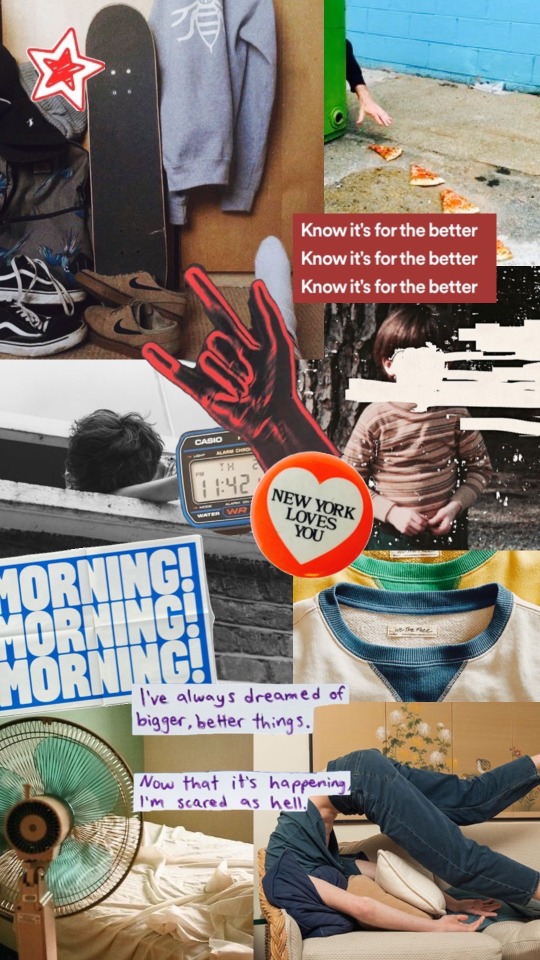
i’ve always dreamed of bigger, better things. now that it’s happening, i’m scared as hell / know it’s for the better, know it’s for the better, know it’s for the better — peter
#ive made so many collages for my other blog so i figured i’d make a couple for this one too! they’re addictive to make#and also very fun#so enjoy this peter one#i also overhauled my pinterest so it’s a bit more organized and cleaned up now#pbp. made in nyc / musings & aesthetics
2 notes
·
View notes
Text
Im thinkin about making a separate blog for my original art/portfolio pieces and keep this a personal/shippy art/fanart blog 🤔
#now that im actually starting to do business things again and tumblr starting to become a hub for artists once more#i feel the need to 'clean up' a bit#ze-pie will never stop being my personal hell lol but for people that like my original work and bigger pieces#itd be nice to have it all in one place#also id for sure be reblogging everything i post on the art blog here#and id still post pearlina stuff and other shippy cringe fanart on this blog#idk im usually horrible at making business decisions so i have no idea if this is a good plan#zepie blabs
28 notes
·
View notes
Text
Merffet's Polar Cube reassembly
Meet my new blorbo, The Cube
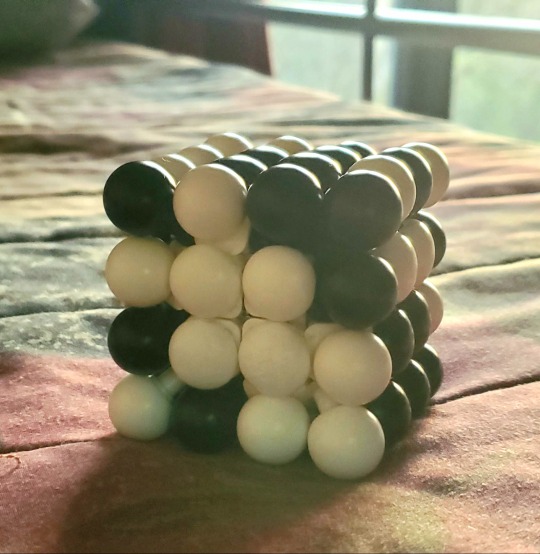
A fidget/puzzle that was on my Christmas list since I couldn't stop playing with the ones at the shops, I took it around with me for like a week.
It's like a rubix cube, but you've got to make the colours alternate.
Sadly, it has been giving me some trouble.
It kept jamming up, despite my attempts to lubricate it, or adjust it using the hidden screws. So I took the plunge and took it apart.
Loosen the top screw enough, and soon the cube was no more.

I couldn't find any guides to this cube online, so I'm making this all up as I go. I carefully noted which parts where where as I pulled it to bits.
These are the parts I found inside:
Corner
Center
Edge
Core attachment link
Inner track bracket
Outer track bracket
Center piece frame
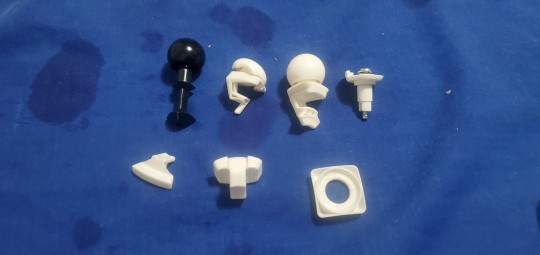
Seeing the cube completely in pieces, after many earlier attempts to fix it, almost makes you want to throw everything out, buy a new cube, and pretend nothing happened.
But I persisted.
I needed to find a place to start. Eventually I managed to wiggle two inner and one outer bracket between two parts of the core.
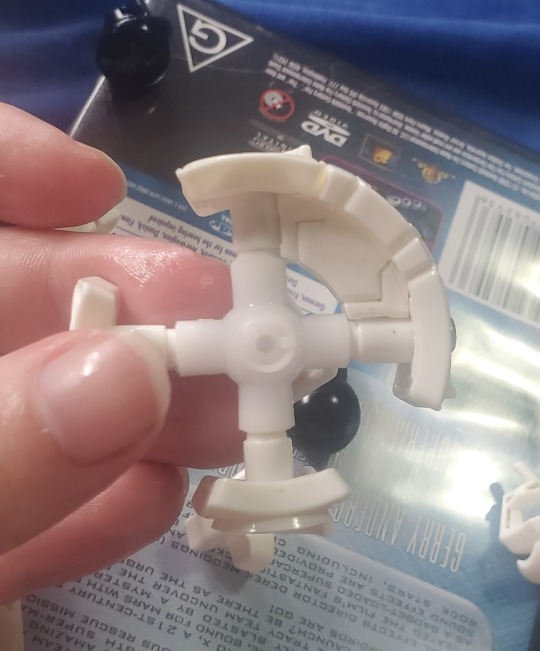
You can also see the little mark which the core attachment point must line up with.
To get the rest in, I had to turn the core plate just slightly. It helps to accept that these parts are intended to slide past each other, and a little unevenness won't cause everything to instantly come undone.
The little gaps in the side seem to be there so you can squeeze the two brackets tight enough that they slip into the gap where eventually, they will sit tight.
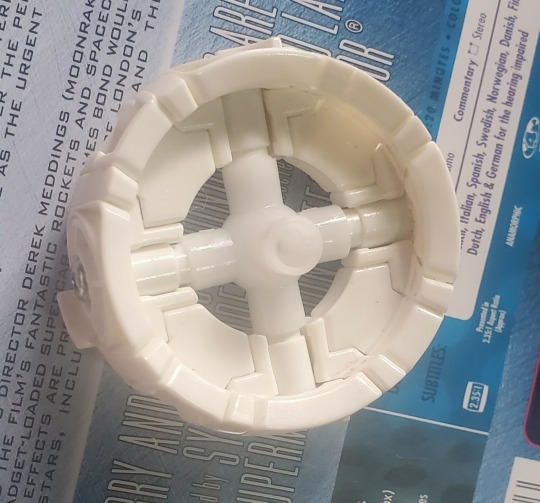
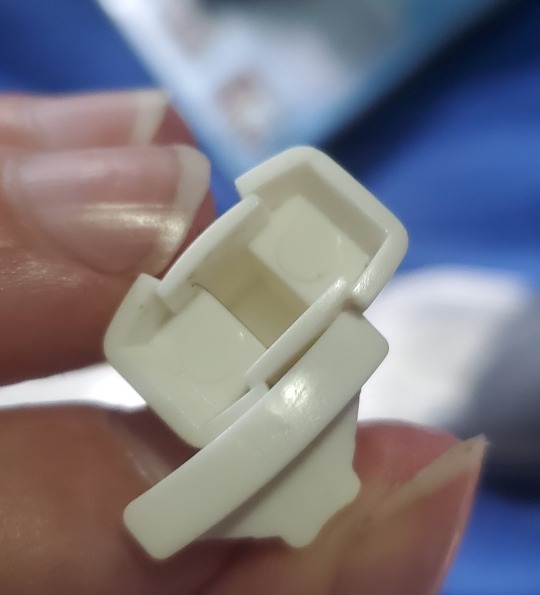
Now I have something firmly attached to the core, and that is enough to really get going.
Doing the first layer of ball segments was just a matter of placing them in the right order and orientation:
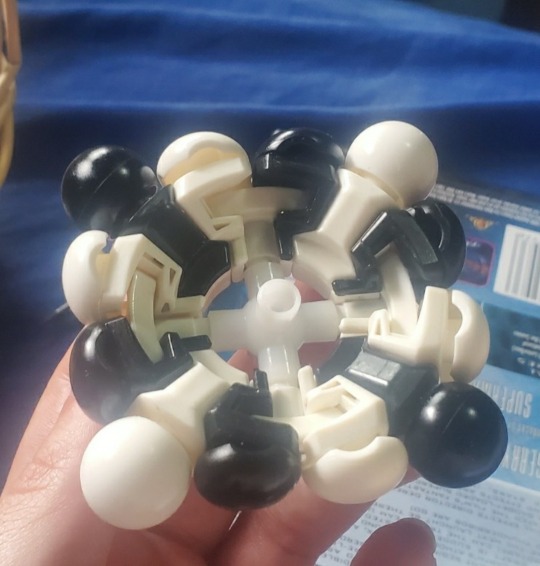
I also added the brackets.
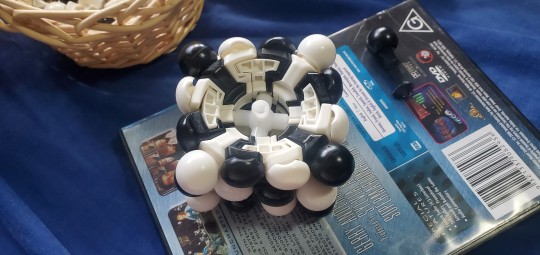
(I did do the layer below as well, but that fell off later, so we shall ignore that for now)
Now the top layer, just got to add the inner brackets and center link,

Then i have to wiggle on the center pieces. The screw needs to be loose enough that can sort of hook them under the plate.
I've left a gap, because the last edge segment and corners need to be jammed in there somehow...

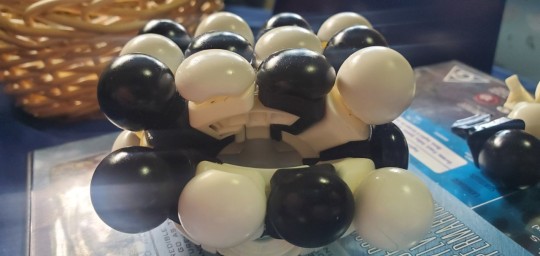
And that's one side done!

Now for the other, which should be much the same
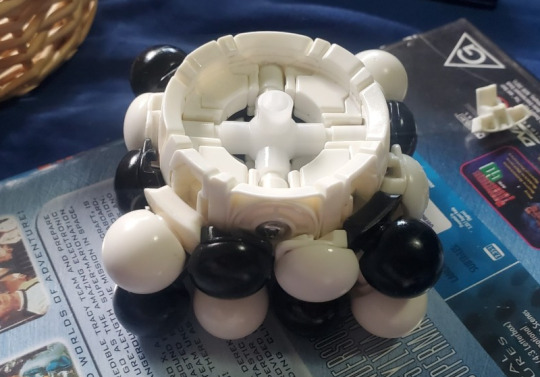
First layer,

Top layer, this time you can see the brackets, ready for me to slip the central link in,

I use a poking tool (awl) to reposition these, when the center pieces go in it helps to be able to slide them to the side so there's more gap to slide the pieces in.
This time I did the last center pieces last, and put the edge in first.

Just got to wiggle in the last pieces, and,
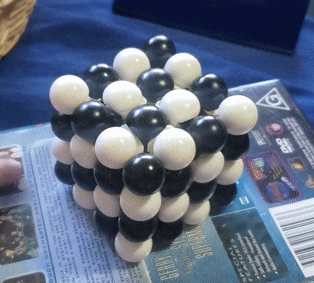
I am done. I also have the puzzle solved, because I needed to make sure it would still be solvable. It's still a little stiff in parts, but now everything is moving again.
I still haven't solved it the normal way.
#The reassembly is now documented should anyone else ever need to fix one of these#look at me using my blog like an actual blog#i did look up videos of 4x4x4 rubix cube reassembly which ha similarities but they weren't the same#i also took the opportunity to clean out all the bits of hair and dust that had got stuck in there - having took this cube with me while#working with children#giving a speedcuber kid a go probably didn't help it's condition#some of the center balls would come of their tracks and the corner got impacted inwards one time#this is hardly the first repair. i had to go on a bit of a run around while on a youth camp to find the guy who could let be use the tech#team's toolkit#anyway this full reassembly took most of the morning. i could probably do it faster now i know how#but i am in no rush to do it again#puzzle cube#puzzle#rubix cube#cube#merfferts puzzles
2 notes
·
View notes
Text
Sometimes I go on a tangent trying to analyze how I feel about or why I do certain things, & I often feel that by focusing on typing it out it's easier for me to actually make conclusions about the "why", but I still don't have a solution & it's kinda frustrating that I do all this analyzing about myself & still feel like a lazy disappointment to everyone around me.
#tmi#brought to you by me typing up what i hate about different cleaning tasks that makes it difficult for me to motivate myself to do#i ended up deleting my vent blog since i haven't used it in forever. i sometimes type these tangents up on masotdon but the character limit-#-makes it annoying & also i feel like I shouldn't post so much of these tangents online. sometimes i end up in a tangent while messaging my-#-s/o. sometimes it happens in the tags of a post i make or reblog#this time i tried just doing it in my phone's notes but when my s/o asked me what i'm doing i ended up rambling to him#i just get so frustrated with myself. very few people like cleaning but ppl do it anyway bc it needs to be done.#all the advice i find is either “just do the thing” or “break it into smaller steps” & the latter is helpful... but i have a hard time-#-figuring out what the smaller steps should be. also i constantly worry about my parents judging how I cleaned something (esp my step dad)#& everything is so exhausting. & everything needs to be done so frequently.#sometimes in certain situations I actually do enjoy cleaning! but it's never at home#i can be so damn productive at work or in class but as soon as it's time to leave my brain shuts off#& @ home it's like my brain can ONLY focus on what it *wants* to do.#i just hate my brain. my meds help a bit but they aren't a magical cure for my laziness
2 notes
·
View notes
Text
requests are open !

opening them finally--
remember to check my rules before you send in a request !
I did change my rules so you have to be off anon to request anything nsfw. I also need to be able to see your age in your profile. Just let me know if you want to stay anonymous and I will crop out your name. I just kind of want to be a bit more comfortable when filling out those requests.
Anons can still request sfw stuff!
I also would like to warn everyone and say I've been getting kicked with a nasty case of writer's block so it may take me awhile to complete some requests !
Love you guys !
#requests are open!#send me the good stuff#also planning on cleaning up my blog a bit here soon so be warned
4 notes
·
View notes
Text
I've done some cleaning today!! I think I am dead now. I really don't have the energy to do the rest of what I want to do, which is a bummer :( Hopefully my sister is able to finish up what I left for her when she gets home!!
#i cleaned the bathroom we share. then i tried to pick up garbage in my room.#i got partway into my garbage collecting when i realised if i keep going it will not end well for me. so i am in bed now.#while i was moving stuff around i found a letter from my ex#so weird seeing proof of how someone used to feel when i know its not like that anymore. i hope hes doing well.#i also found a card i got from a mutual and im gonna tuck both of those away into my memory box :3#but yeah i am very dead now.#i need to pick up the garbage and then deal with some laundry and then i REALLY need to vacuum and theres no way im doing all that today.#having a bit of an asthma attack but i done even have it in me to walk 4 steps to my inhaler ._. guess i will suffer.#i am so tired ._.#glad i finally got around to cleaning up the bathroom though. it was pretty awful.#batty blogging#text
4 notes
·
View notes
Text
#ive been considering it a little bit since i feel bad for reblogging in bulk. might also queue reblogs on my main based on this poll#i need to clean up this blog in particular too.. organization tags Shudders
3 notes
·
View notes
Text
YOU CAN CHANGE FEATURED TAGS ON YOU BLOG??
#goodbye existence of hetalia#grass eats ass#also having a tumblr midlife crisis. you can private posts but very slowly so ill be doing that.#just cleaning up the blog a bit
2 notes
·
View notes
Text
Soft Reboot
Decided to do a soft reboot and essentially redraw/lead up to the previously drawn pages back from 2018, and hopefully it'll have much better pacing 😭✌
So!! Essentially! The previous pages? Not canon and will be disregarded kinda! The characters/events will technically still happen, but with a lot more thought put into them, so it isn't as rushed jhdjkf
Old pages and everything else will stay up for preservation’s sake, and to just see how much I have improved over the years XD
Also!! Scheduling wise!! I'm not going to give myself a hard schedule, as it'll only stress me out, so this blog will stay true to the “sometimes” part of it! XD
I'll be accepting asks as soon as I post the official “first” post, which is already finished! :D
i mean the askbox is technically open now, but yknow XD
#the mod speaks#update#///god this blog is gonna need cleaning up too#but i won't be deleting anything bc i! do not have the original files anymore!!#which sucks!!!#anywho i am a bit nervous at 'restarting' this whole thing again XD#well; technically restarting this arc jghsdfjkg#i'd also like to think that i've learned a whole lot from planetsparalysis#in terms of doing comics n whatnot#but even still i have a lot more to learn XD
2 notes
·
View notes